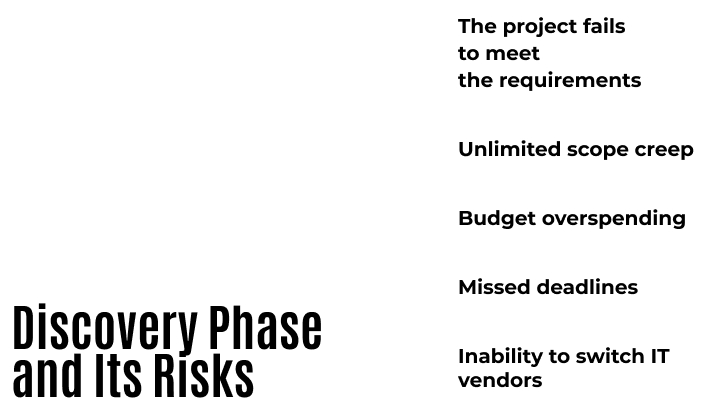If you have a software project idea that you believe will significantly benefit your business, it is important to take a step back before starting the design and development process. It’s crucial to identify the exact problems your project will solve, determine your target audience, assess whether your solution will truly provide value, and consider other important factors.
This is where the discovery phase comes in – it’s a critical part of the project lifecycle that helps to bridge the gap between the concept and the actual implementation while also defining what success looks like.
In our article, we’ll tell how important the discovery phase is, describe the main roles and steps of discovery phase process. Let’s start our guide!
Discovery Phase Definition
During the project discovery phase, the target market is analyzed, the product-market fit is defined, and all project requirements and goals are gathered. Unfortunately, some individuals overlook this phase, viewing it as a squandering of time and resources. The most common reason companies fail is a lack of product-market fit. 42% of businesses said their clients had no market need for their products.
Yet, this stage is critical in helping companies to gain a deeper understanding of their customers and create products that effectively address their customers’ challenges. Consequently, the discovery phase delivarabilities enhance the development process organization and links clients’ business objectives with their users’ needs.

The Key Roles of the Discovery Stage
The primary objective of the software development discovery phase is to identify and mitigate potential risks such as a lack of market demand, unforeseen expenses, and the inability to pay for them. Mistakes made during the planning stage are typically more costly to rectify later, which is why the software development discovery phase focuses on testing ideas and implementation strategies, optimizing development costs, and accelerating product launch. This phase plays a critical role in project management and is applicable to products of any complexity or industry.

To illustrate, we will outline our experience in developing an online mortgage platform in the fintech sector. In summary, the discovery phase assists with:
Establish business goals
Establishing business goals is a key component of the discovery phase in software development. This involves creating a product scope, defining product requirements, and setting business goals. It is essential to stick to these goals throughout the development process and keep them in mind when making any changes to the product.
Understand what a successful outcome looks like
It’s not enough to just outline the goals of a product during the discovery phase. It’s also crucial to determine how many of these goals need to be met to achieve a successful outcome. As a business owner, you should understand what you want to achieve with your product. Even if you don’t reach 100% of your goals, meeting 70% of them might still be enough to satisfy your initial requirements.
Carry out user research
Carrying out user research is a vital aspect of the project discovery phase. Understanding the needs and wants of potential users is critical in developing a successful product. For example, when developing an online mortgage platform, market research revealed that customers consider not only the lender’s reputation, mortgage rates, and fees but also the duration of the mortgage process, transparency, and the speed of communication. Quality software is crucial to establishing trust with customers, and applications should be adapted to the realities of the target region, including legal and security regulations.

Map the customer journey
Mapping the customer journey is another crucial aspect of the discovery phase. This involves creating a customer journey map to identify main touchpoints that users interact with and anticipate any difficulties users might encounter. Even for MVPs, customer journeys should be mapped out in detail to ensure that their first experience with an application is satisfactory. Analyzing why users don’t complete a product’s journey is important in understanding what is blocking them, such as inadequate UX/UI or user reluctance to buy. Developing and testing the customer journey during the discovery phase ensures that nothing will prevent customers from achieving their goals.
Analyze the competitors
Analyzing competitors’ strengths and weaknesses is also an essential part of the discovery phase. This helps find gaps in the industry and understand how a product can fill them. It also helps in developing a unique value proposition and making the product stand out. With the help of competitors analysis, we can find out the main competitors’ mistakes to avoid them in our business model and products.

Reasons for the Discovery Phase and Its Benefits
The project discovery phase is often viewed as a waste of time, especially when everyone is eager to get the product off the ground. According to Mckinsey study on software project implementation, an average large IT project exceeds its budget by 45%, while the benefits shortfall is 56% less than expected. So, the discovery phase business analysis is an essential step for successful development as it provides several benefits, including:
Minimizing risks
Having a clear understanding of the project’s goals and requirements enables the development team to make accurate estimates of the project’s time and budget, reducing the risk of missed deadlines by up to 75% and potentially saving more than 50% in overall costs. Ultimately, the project discovery process can make the difference between success and failure.
Establishing a roadmap
With a clear set of requirements, the development team can create a step-by-step plan to take the product from an idea to launch without any rescheduling or changes. The project timeline will include interim goals, deliverables, and deadlines, and the SRS and wireframe prototypes developed during the stage discovery can increase the startup’s feasibility with investors and attract additional funding.
Building trust
Even after a compelling sales pitch, it’s challenging to be entirely confident in your IT vendor choice. However, regular communication and in-depth project discussions with the development team can ease your mind and establish mutual trust. Alternatively, you may realize that you’ve chosen the wrong company and switch vendors before it’s too late and your budget is depleted.
Real-time data controls
Using established controls or environmental factors, businesses can apply specific actions to the data they gather in real-time, assuring proper storage and analysis and legal and secure data practices. Data discovery is critical to achieving this level of management.
If you decline the discovery phase project plan, and development begins without a clear understanding. You can expect the following outcomes:
The project fails to meet the requirements
Miscommunication at the beginning of an engagement leads to further misunderstandings. They result in a gap between your ideals and reality and wasted time and money.
Unlimited scope creep
Without measurable results, the project execution goes on forever, and its launch is postponed. New standards and features wreak chaos on the development team.
Budget overspending
The absence of specific goals and guidance leads to constant requirement changes, which raises costs. You run out of funds before the team is able to produce a completed or at least usable product.
Missed deadlines
Aside from overspending, scope creep causes changes in the development timetable and slows delivery deadlines. Missed dates mean huge company losses in a competitive market.
Inability to switch IT vendors
When you’ve had enough of working with the development team, switching to another is virtually difficult without preliminary documents. You might as well start all over again, this time without skipping the research process.

The Discovery Phase Process
In addition to stakeholders, the stage discovery typically involves several specialists, including a business analyst, tech lead, project manager, and UX/UI designer.
Step 1: Selection
The initial stage of the discovery phase involves selecting how to handle it. Below are several ways that companies can operate discovery phase activities, so you can choose the one that suits you best.
Dedicated Team
The discovery phase in software development necessitates specialists with various areas of expertise. At EVNE Developers, we can form a team composed of a business analyst, project manager, UX/UI designer, and software architect, ensuring that you have all the necessary expertise for the discovery phase of a software project. Each team member is selected through a rigorous screening process and is approved by you.
The team works with you exclusively and full time, and you have complete control over the discovery process. We can even provide software developers when you are ready to move on to an MVP. The discovery phase begins immediately after signing an NDA with you and the team.
Traditional outsourcing
Another option for operating the stage discovery is to find a vendor who will use their in-house team to fulfill your vision. In this way, you will be less involved in the discovery process and will only receive deliverables that you and the vendor agreed upon and established in the contract. Although outsourcing is one of the most cost-effective options available, there is always a risk that the discovery phase of a software project will be handled by someone lacking domain expertise and technical competence. After all, creating a vital document such as SRS requires an expert touch.
Freelancers
Finally, there is an option to fill all the vacancies you require for the discovery phase project plan by searching freelance platforms. While many skilled professionals are available for freelance work, hiring from Upwork (or any other platform) may expose your Intellectual Property to someone who is not bound by a contract and can potentially use your vision to create a competing product.
Another concern is managing your freelancers
The project management discovery phase necessitates close collaboration between all team members. Compared to Dedicated Team and Outsourcing models where team members work together in-house, synchronizing and controlling the work of freelancers can be problematic, resulting in delays.
Step 2. Analysis (Business Goals)
During the product development process, it’s essential to determine the features that will be included based on your goals. To achieve this, a business analyst will collaborate with you and other stakeholders to discuss your vision and objectives. In the course of the interview, the business analyst will aim to obtain answers to the following questions:
- What problem will your software solve?
- Are there existing solutions that already address the same problem?
- What sets your solution apart from others?
- What are the critical features required for your product?
- Which market segment will you target?
- What are the preferred platforms of your target audience?
If necessary, the business analyst can also conduct research independently to evaluate the market potential of your product and analyze the competition in your niche.
Step 3. Feature Identification
To determine the features that will make up your product, a business analyst will meet with you and other stakeholders to discuss your vision and goals. During the interview, they will focus on important questions such as the problem your software will solve, the existing solutions to that problem, what sets your solution apart, your target market, and the preferred platforms for your audience. Based on these answers, a project manager will then prioritize and document the product features. During this process, it’s essential to distinguish between key features and ones that can be added later.
Step 4. Wireframe Design
A wireframe is a preliminary design that maps out the user’s path through the software, including transitions between software elements. Wireframes are created based on user stories and are crucial in explaining how users navigate the software. Though they lack attractive UI elements, they include core functions and how users should interact with them.
Step 5. Prototyping
Once the wireframes are approved, a UX/UI designer will use them to create a design concept. This step allows you to preview the product’s interface before development begins, ensuring that it will look and function as intended.
Step 6. Technical Documentation
Next, a business analyst and software architect work together to create Software Requirements Specifications. This document is a guide that outlines the final product’s purpose, market niche, competitors, stakeholders’ goals, ways to implement software, including architecture solutions, technologies, and third-party integrations, use cases, user stories, MVP scope, interface components, technical risks, and future development projections.
Step 7. Development
With the technical specification document in hand, the development of your MVP can begin. It’s essential to keep the document handy throughout the development process as a guide.

What is Project Discovery Checklist?
To ensure that the team has all the necessary information before proceeding with project planning and execution, we utilize a project discovery checklist that includes the following:
- Company/Client: The primary goals of the company/client, the target audience, any existing research and marketing materials, and reasons for change (if the project is not being developed from scratch).
- Current Offers: Any existing products and services, buying habits, prospect-to-customer transition factors, and customer service effectiveness.
- Market: Online and offline research, industry-specific publications, subscriptions, and whitepapers.
- Competition: Analysis of primary and secondary competition, including competitive features and unique selling propositions.
- Audience: Detailed information about the target audience, customer avatars, and user scenarios.
- Marketing: Current marketing strategy and methods, short and long-term measurable goals, branding strategy, approach, and message.
- Current Solution: Results of usability tests, customer feedback, content audit, technology stack, and analysis of the feature set.
- Technical Requirements: A system requirements specification that includes a list of features, solutions, and an updated technology stack.
- Other: Additional industry-specific data that provides a more in-depth understanding of the market’s requirements.

Conclusion
The project management discovery phase is crucial for laying the groundwork of your product, which will ultimately affect its future success. This phase involves defining your product’s goals, studying your target audience’s needs, analyzing competitors, planning the budget, and devising a well-thought-out strategy.
To ensure a smooth and confident development process for your software product, reach out to the EVNE Developers team for their expertise in the discovery phase proposal.


















